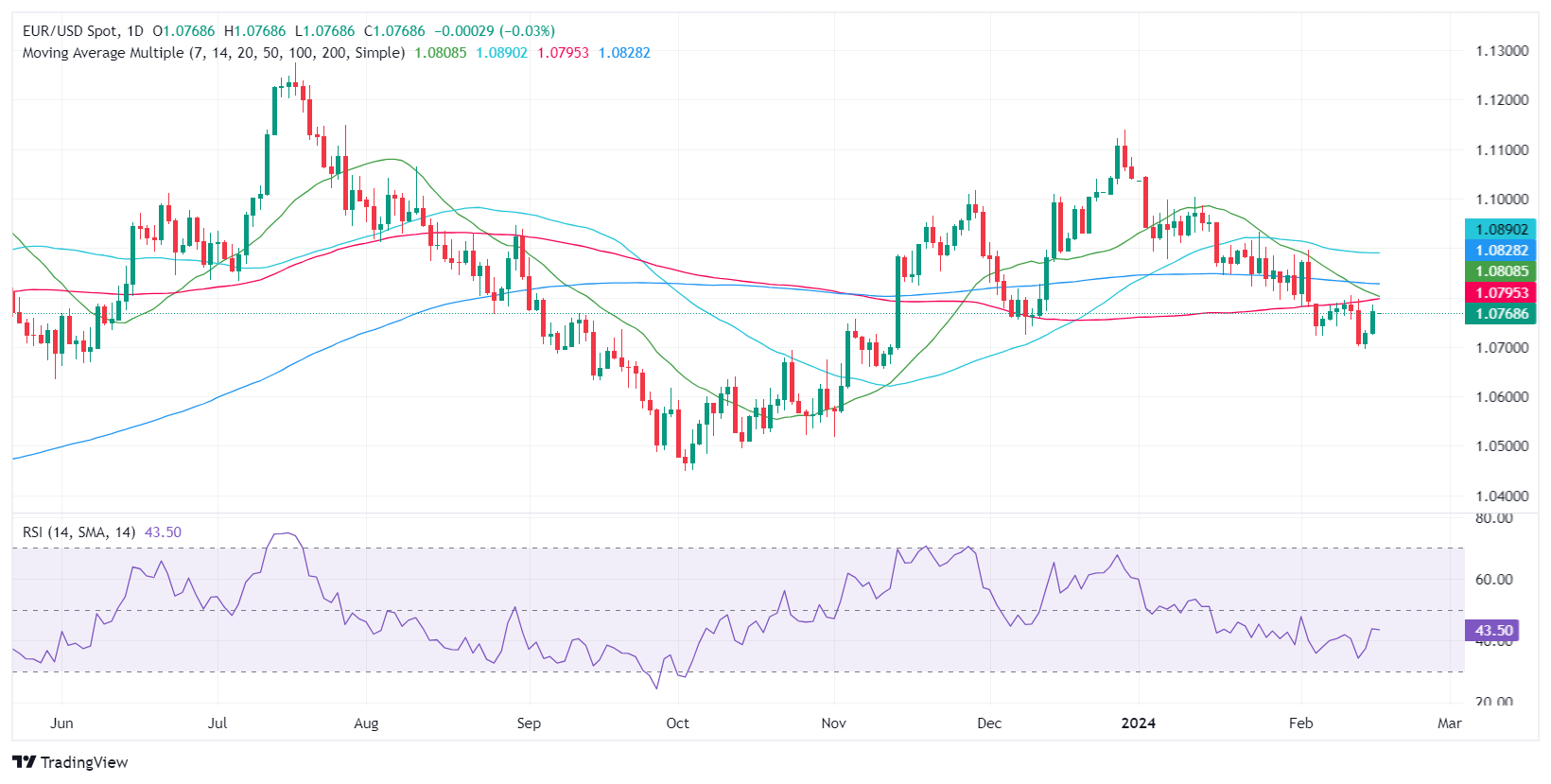- EUR/USD falls to 1.0759 as US inflation data beats expectations, suggesting sustained focus from the Fed.
- The rise in the January PPI in the US highlights the persistence of inflationary pressures, and the core PPI exceeds forecasts.
- The ECB's caution in cutting rates highlights concerns about inflation, in clear contrast to the Fed's fight against inflation.
The Euro (EUR) retreats after reaching a new two-day high, while the United States (US) producer inflation index suggests that the US Federal Reserve's job is not done . The dollar rose as interest rate traders have begun to align with the Fed's vision of three rate cuts by 2024. At the time of writing, the EUR/USD pair is trading at 1.0759, down 0.08 %.
EUR/USD falls due to the increase in the PPI in the US
The US Bureau of Labor Statistics (BLS) revealed that the January Producer Price Index (PPI) rose 0.3% month-on-month, beating estimates, while the core PPI also beat forecasts and jumped sharply to 0 .5% month-on-month from -0.1% in December. In the 12-month figures through January, the PPI rose 0.9%, less than in December, but the core PPI rose 2%, above estimates of 1.6% and 1.8% in December.
Sources cited by Bloomberg stated: “Inflation has gained momentum in recent years and persists in many corners of the economy despite falling prices for gasoline, basic foods and durable goods.”
The Fed closely follows the PPI because several categories in the report are used in the Fed's preferred inflation gauge, Personal Consumption Expenditure (PCE).
After the data was released, the EUR/USD fluctuated between 1.0770 and 1.0730, before stabilizing around current rates. US Treasury yields rose, while the Dollar Index (DXY) advanced 0.22% to 104.50 points.
Other data from the United States revealed that building permits fell -1.5%, from 1.493 million to 1.47 million, while housing starts plummeted sharply, -14.8%, from 1.562 million to 1.331 million.
Across the pond, the Eurozone (EU) economic agenda was light, with Germany revealing January wholesale prices, which rose 0.1% mom, but on an annual basis fell -2.7% down from -2.6 % from December.
Turning to central banks, Isabel Schnabel, a member of the European Central Bank's Governing Council, said the central bank must be careful not to cut rates too soon and that monetary policy must remain restrictive. This is because fears of an inflation rebound persist around ECB policymakers
EUR/USD Price Analysis: Technical Outlook
From a technical point of view, the EUR/USD pair has a bearish bias despite having recovered in recent days. However, if buyers push prices towards the 100-day moving average (DMA) at 1.0796, that could pave the way to challenge 1.0800. On the other hand, if sellers keep the pair below the psychological zone of 1.0750, the door could open to test the February 15 low at 1.0723, before 1.0700.

EUR/USD
| Overview | |
|---|---|
| Latest price today | 1.0769 |
| Daily change today | -0.0003 |
| Today's daily variation | -0.03 |
| Today's daily opening | 1.0772 |
| Trends | |
|---|---|
| daily SMA20 | 1.0808 |
| daily SMA50 | 1,089 |
| SMA100 daily | 1.0795 |
| SMA200 Journal | 1.0828 |
| Levels | |
|---|---|
| Previous daily high | 1.0785 |
| Previous daily low | 1.0725 |
| Previous weekly high | 1.0795 |
| Previous weekly low | 1.0723 |
| Previous Monthly High | 1.1046 |
| Previous monthly low | 1.0795 |
| Fibonacci 38.2% daily | 1.0762 |
| Fibonacci 61.8% daily | 1.0748 |
| Daily Pivot Point S1 | 1.0736 |
| Daily Pivot Point S2 | 1.07 |
| Daily Pivot Point S3 | 1.0676 |
| Daily Pivot Point R1 | 1.0796 |
| Daily Pivot Point R2 | 1,082 |
| Daily Pivot Point R3 | 1.0856 |
Source: Fx Street
I am Joshua Winder, a senior-level journalist and editor at World Stock Market. I specialize in covering news related to the stock market and economic trends. With more than 8 years of experience in this field, I have become an expert in financial reporting.







